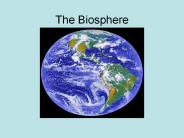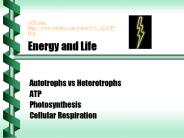Heterotroph PowerPoint PPT Presentations
All Time
Recommended
Heterotrophs Food for heterotrophs Changes in food through time What animals need for digestion Mechanical breakdown of food Heterotrophs All animals All fungi Some ...
| PowerPoint PPT presentation | free to view
Title: PowerPoint Presentation Author: Primary User Last modified by: Mike Created Date: 3/8/2005 2:47:07 AM Document presentation format: On-screen Show (4:3)
| PowerPoint PPT presentation | free to view
Title: PowerPoint Presentation Author: Jason E. Meade Last modified by: Martinez, Maria O Created Date: 4/12/2002 12:43:12 AM Document presentation format
| PowerPoint PPT presentation | free to download
Title: Photosynthetic Prokaryotes Chapter 14 Author: Jeffery Hughey Last modified by: Hartnell Created Date: 6/28/2004 5:07:39 PM Document presentation format
| PowerPoint PPT presentation | free to download
By Abdul Manap Mahmud Introduction Definitions of heterotrophic on the Web: Refers to organisms, such as animals, that depend on preformed organic molecules from the ...
| PowerPoint PPT presentation | free to download
... Fungi come in many shapes and sizes. Sac fungi form a reproductive sac, or ascus. Yeasts = single-celled sac fungi. Morels and truffles = multicellular sac fungi.
| PowerPoint PPT presentation | free to download
All fungi are eukaryotic heterotrophs that have rigid cell walls made of chitin What is eukaryotic? Fungi have a nucleus and membrane-bound organelles What is a ...
| PowerPoint PPT presentation | free to view
... are unfavorable. The Role of Fungi in Nature Food and Fungi Yeasts make bread rise Molds are used to make cheese Mushrooms on pizza yum!
| PowerPoint PPT presentation | free to download
Title: WAS Orlando 1-24-01 AES Presentation Subject: Biofilter Kinetics Author: James M. Ebeling Keywords: Biofilter, Beadfilters, Kinetics Description
| PowerPoint PPT presentation | free to download
Title: Chapter 5 Gases Author: Ioana Popescu Last modified by: Ioana Popescu Document presentation format: On-screen Show (4:3) Company: Jacqueline Bennett
| PowerPoint PPT presentation | free to view
Kingdom Protista: Algae and Heterotrophic Protists Chapter 15 Heterotrophic Phyla Oomycota- water molds. Myxomycota- plasmodial slime molds. Dictyosteliomycota ...
| PowerPoint PPT presentation | free to view
Heterotrophic Bacterial Communities Associated with Desert Gypsum Rock. By Leigh Ann Beasley ... Dr. Braun. Dr. Clower. Dr. Whittman. Chris Lasher. Questions? ...
| PowerPoint PPT presentation | free to view
Saprophytic and engulf bacteria, yeast, fungal spores. Food reserve- glycogen. ... Photosynthetic Prokaryotes Chapter 14 Author: Jeffery Hughey Last modified by:
| PowerPoint PPT presentation | free to view
Fungi are adapted to absorb their food from the environment. ... called basidia. include mushrooms, puffballs, and. shelf fungi. 19.5 Diversity of Fungi ...
| PowerPoint PPT presentation | free to download
Organism that has the ability to produce it's own energy/food. Photosynthesis (light) ... Organisms that feed on meat: Meat-eater. Bear, anteater. Omnivore ...
| PowerPoint PPT presentation | free to view
Secondary metabolites and other biologically useful compounds. Genetic Diversity. Cryptosporidium ... Marine Invertebrate Guts. Nutritious environment for heterotrophs ...
| PowerPoint PPT presentation | free to view
Sand Dollar. Pacific Oyster. www.manandmollusc.net. Peanut Worm ... There are many diverse groups of protists to be discovered by basic exploratory research. ...
| PowerPoint PPT presentation | free to view
The flow of food energy into and out of an animal can be viewed as a 'budget' ... hydra captures its prey with nematocysts and stuffs the prey through the mouth ...
| PowerPoint PPT presentation | free to view
... to be the more definitive sign of overyielding (Hector et al, 2002) ... Hector, Andy et al. 'Overyielding in grassland communities: testing the sampling ...
| PowerPoint PPT presentation | free to view
Carbon Cycles through Organisms in Respiration autotrophes heterotrophes
| PowerPoint PPT presentation | free to download
Title: 31.1 Animals are multicellular heterotrophs without cell walls. Some General Features of Animals Animals are multicellular heterotrophs that are diverse in ...
| PowerPoint PPT presentation | free to view
Taxonomy and Classification The Six Kingdoms Archaebacteria Prokaryotic Unicellular Reproduces asexually Heterotrophic, but sometimes autotrophic Heterotrophic ...
| PowerPoint PPT presentation | free to download
Title: - Heterotrophic Plate Count Subject: Author
| PowerPoint PPT presentation | free to download
What Characteristic Define an Animal? Eukaryotic cells Multicellular Ingestive Heterotroph
| PowerPoint PPT presentation | free to download
Review the Animal Kingdom 4 Major Characteristics? Multicellular Eukaryotic Heterotrophs Cells lack cell walls
| PowerPoint PPT presentation | free to download
Animal Diversity 2 Multicellular, eukaryotic, heterotrophic organisms that feed by INGESTION
| PowerPoint PPT presentation | free to view
The Origin and Chemistry of Life Chapter 2 * * * * * * * * * * * * * * * * * * * * * * * * * * * * * * * * * * * * * * * Precambrian Life Heterotrophs that ate ...
| PowerPoint PPT presentation | free to view
The Biosphere Vocabulary Ecology Biosphere Species Population Community Ecosystem Biome Producer Consumer Autotroph Heterotroph Decomposer Learning Target I can ...
| PowerPoint PPT presentation | free to download
The Biosphere Vocabulary Ecology Biosphere Species Population Community Ecosystem Biome Producer Consumer Autotroph Heterotroph Decomposer Habitat Learning Target I ...
| PowerPoint PPT presentation | free to download
Classification Biology I Kingdom Animalia All eukaryotic, multicellular, heterotrophic, motile (most) organisms Common Phyla: Porifera (sponges, corral) Cnidaria ...
| PowerPoint PPT presentation | free to view
Fungus Characteristics -eukaryotic cells - multicellular / unicellular (yeast) - heterotrophs : many are decomposers Structures - hyphae : basic unit of multicellular ...
| PowerPoint PPT presentation | free to view
The Kingdom ANIMALS Eukaryotic cells Multicellular Heterotrophic by ingestion External Fertilization vs Internal Fertilization a. Invertebrate Chordates: Tunicates ...
| PowerPoint PPT presentation | free to view
KINGDOM ARCHEABACTERIA Unicellular Prokaryotes Extremophiles (heat, salinity, acid, etc) Autotrophic/chemosynthetic and heterotrophic DNA structure similar to ...
| PowerPoint PPT presentation | free to view
Photosynthesis Photosynthesis in nature Autotrophs: biotic producers; make their own food photoautotrophs; chemoautotrophs Heterotrophs: biotic consumers; obtain ...
| PowerPoint PPT presentation | free to download
Lab 6 Various Protista Dictyosteliomycota Common name: Cellular slime molds Synonyms: Acrasiomycota (in part) Mode of nutrition: Heterotrophic: ingestive ...
| PowerPoint PPT presentation | free to view
... combining photosynthesis and heterotrophic nutrition Characteristics Protists are ... Giardia Trypanosomes Malaria Cute Paramecium Amoeba Mistaken as other ...
| PowerPoint PPT presentation | free to view
Biology 2: Form and Function Overview of fungi Heterotrophs Extracellular digestion Some fungi capable of digesting lignin Non-cellulose, chitin-impregnated cell ...
| PowerPoint PPT presentation | free to view
Kingdoms protista, fungi, plantae, animalia Protista Unicellular Some autotrophic-algae Some heterotrophic Mostly found in aquatic habitats Endosymbionts live ...
| PowerPoint PPT presentation | free to view
9 Phyla of the Animal Kingdom Common Animal Characteristics Multicellular (many cells) Eukaryotic (cells contain nucleus) Heterotrophic (must eat) Lack cell walls ...
| PowerPoint PPT presentation | free to view
EVOLUTION OF ANIMALS CHARACTERISTICS OF ANIMALS Multicellular Eukaryotic Heterotrophic (ingestion) No cell walls Nervous & muscle tissue Sexual reproduction Hox genes ...
| PowerPoint PPT presentation | free to view
Photoautroph heterotroph chemoautotroph 2.1 Cellular Respiration: The Big Picture Overview of Cellular Respiration Process of Cellular Respiration Glycolysis ...
| PowerPoint PPT presentation | free to view
Chapter 11 Protists Protist Charateristics Protists unicellular or multicellular eukaryotes that may be autotrophic or heterotrophic Autotrophs are organism ...
| PowerPoint PPT presentation | free to view
CHAPTER 18 CLASSIFICATION (Taxonomy) THE SIX KINGDOMS Animalia Eukaryotic Heterotrophic Multicellular Movement Organized into tissues and organs (most animals ...
| PowerPoint PPT presentation | free to view
Photosynthesis SPI.3.3 Compare and contrast photosynthesis and cellular respiration in terms of energy transformation. Energy Ability to do work Autotroph Heterotroph ...
| PowerPoint PPT presentation | free to view
FUNGI What do you know about fungi? General Characteristics Multi-cellular and eukaryotic Heterotrophs Saprophytes, parasites, symbionts, decomposers Releases ...
| PowerPoint PPT presentation | free to view
Animals are multicellular, heterotrophic, eukaryotes ... Keeled toucan. Linnaean Classification. Kingdom: Animalia. Phylum: Chordata. Subphylum: Vertebrata ...
| PowerPoint PPT presentation | free to download
Kingdom Animalia Characteristics Multicellular Eukaryotic with no cell walls Heterotrophs (consumers) Have a nervous system to respond to their environment ...
| PowerPoint PPT presentation | free to view
ATP song https://www.youtube.com/watch?v=V_xZuCPIHvk Energy and Life Autotrophs vs Heterotrophs ATP Photosynthesis Cellular Respiration
| PowerPoint PPT presentation | free to download
Kingdom Animalia Animals are: Multicellular, with tissues and organ systems that perform specialized functions Eukaryotic, with no cell walls Heterotrophic
| PowerPoint PPT presentation | free to view
Archaea Resemble bacteria superficially but may be more closely related to eukaryotes than bacteria May be heterotrophs or autotrophs Methanogens
| PowerPoint PPT presentation | free to download
3-2 Energy Flow Two energy sources: Sunlight (Photosynthesis) Inorganic chemicals (Chemosynthesis) Autotrophs (Producers)- capture energy & make food Heterotrophs ...
| PowerPoint PPT presentation | free to download
PHOTOSYNTHESIS AUTOTROPHS Auto = self Troph = eating Organisms that can produce their own food (energy) from inorganic materials (sunlight) HETEROTROPH Hetero = other ...
| PowerPoint PPT presentation | free to download
Secondary Education Heterotrophic nutrition Heterotrophic organisms cannot make organic matter from inorganic matter. Therefore, ...
| PowerPoint PPT presentation | free to download
Photosynthesis Chapter 8 Trophs Autotrophs Heterotrophs The Meaning of Life Photosynthesis 6CO2 + 6H2O C6H12O6 + 6O2 Photosynthesis uses the energy ...
| PowerPoint PPT presentation | free to download
A: Discovery Channel LIFE Scientific name = Dionaea muscipula Kingdoms! Biology 11 Eubacteria Prokaryotic Autotrophs and Heterotrophs Unicellular Some capable of ...
| PowerPoint PPT presentation | free to view
Kingdom Animalia What s an Animal? Eukaryotic multicellular heterotrophs without cells walls. This includes a HUGE number of organisms you may not think of as ...
| PowerPoint PPT presentation | free to view
























































